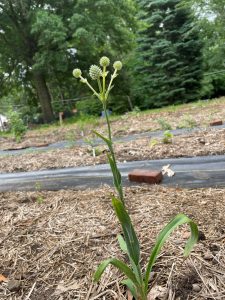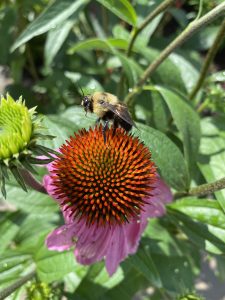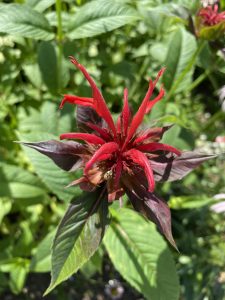Eryngium yuccifolium – Rattlesnake Master

When you think of pollinators, your mind may automatically go to bumble bees. In reality, plants are pollinated by many more things than just bumble bees. One local species that is worth highlighting from the College Garden is Rattlesnake Master. This species of plant is particularly known for attracting a diverse range of pollinators (1). Rattlesnake master is mainly pollinated by yellow-faced bees, sweat bees, bumble bees, wasps and flies . This plant also acts as a host to several species of moth larvae, and are an essential step in completing their life cycle.
Photo Credit: Ashley Arons
Echinacea purpurea – Purple Coneflower

Another plant that is specifically used to attract pollinators that can be found in our gardens are Purple Coneflowers. This species of plant is native to Ohio. It has been shown that native flowers can help improve the species richness and abundance of bees (2). This species of plant is also pollinated by a wide variety of insects including bees and butterflies. Some types of bees that you may see pollinating this plant are honey bees, bumble bees and native leaf cutter bees(3). Some butterfly species you may see on these plants are Monarch and Swallowtail butterflies. Like Rattlesnake Master, this plant is also the host for butterfly larvae and help them in their life cycles.
Photo Credit: Ashley Arons
Monarda didyma – Scarlett Beebalm

A final plant that we have in our pollinator patches is Scarlett Beebalm. After talking about different bee species on this page and despite the plant having bee in its name, you may be surprised to find out that bees are not the primary pollinator for this plant. Insects are not the only organisms that can pollinate plants, it can also be done by mammals and birds. Though it is still visited by bees, the main pollinators of this plant are ruby-throated hummingbirds and butterflies (4).
Photo Credit: Emily Greenland
Works cited
(1) Wheeler, J., & Authors Justin Wheeler Xerces Contributor Justin was formerly the Xerces Soc. (n.d.). Weird and wonderful plants for pollinators: Rattlesnake master. Weird and Wonderful Plants for Pollinators: Rattlesnake Master | Xerces Society. https://xerces.org/blog/rattlesnake-master.
(2) Turo, K. J., & Gardiner, M. M. (2019). From potential to practical: Conserving bees in urban public green spaces. Frontiers in Ecology and the Environment, 17(3), 167–175. https://doi.org/10.1002/fee.2015
(3) Purple Coneflower (echinacea purpurea). (n.d.). http://www.illinoiswildflowers.info/prairie/plantx/pur_coneflowerx.htm.
(4) U.S. Forest Service. Forest Service Shield. (n.d.). https://www.fs.fed.us/wildflowers/plant-of-the-week/monarda_didyma.shtml.
EZ made this page to increase plant appreciation as a part of Wooster’s Field Botany course in Fall 2021.